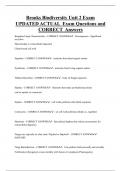Exam (elaborations)
Brooks Biodiversity Unit 2 Exam UPDATED ACTUAL Exam Questions and CORRECT Answers
- Course
- Institution
Brooks Biodiversity Unit 2 Exam UPDATED ACTUAL Exam Questions and CORRECT Answers Kingdom Fungi Characteristics - CORRECT ANSWER- Decomposers - Significant recyclers Heterotrophs w extracellular digestion Chitin-based cell wall Saprobes - CORRECT ANSWER- nutrients from dead organic matter ...
[Show more]




